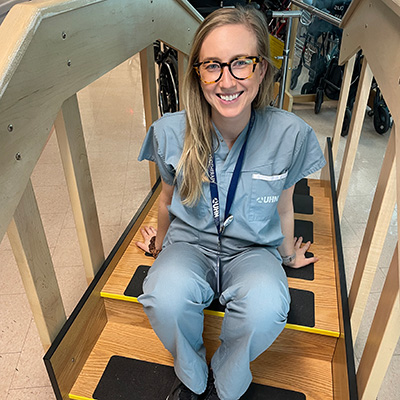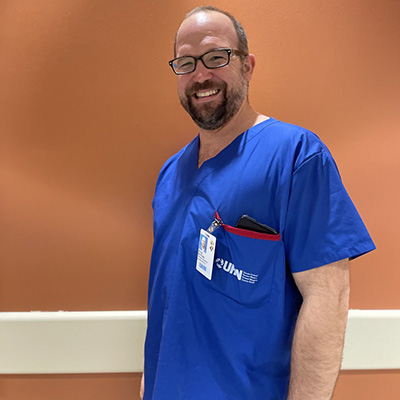They bring their A-game every day, to help patients meet their goals. Their expertise focuses on restoring mobility and function, in the face of an injury or illness, but patients are quick to call them cheerleaders, confidants, consolers and friends.
They are UHN's physiotherapists (PTs) and physiotherapy assistants (PTAs). And this month – National Physiotherapy Month in Canada – we celebrate the essential role they play within multidisciplinary teams.
“From getting moving post-surgery, to maximizing mobility and functional independence, to collaborative discharge planning, PTs and PTAs support patients at every stage of their journey," says Trish Stapleford, Discipline Head, Physiotherapy and Kinesiology at UHN.
Meet five PT/PTAs from across UHN, and learn more about how they impact the patients they serve.
Bonnie Cai-Duarte, PT, Toronto Rehab

Where can we find you? I work at Toronto Rehab's Rumsey Centre, dividing my time between our Outpatient Acquired Brain Injury (ABI) Program, and the Living Engaged and Actively with Pain (LEAP) Service, where, through group treatment, we help patients living with neurological conditions, such as multiple sclerosis, ABI, stroke, and spinal cord injuries, rebuild their quality of life after their injury and learn to "live with the pain."
What motivates you to 'bring it' every day? Seeing patients reach their own "ah-ha" moment, when they realize they have what it takes to meet their goals, working slow and steady. A lot of my work involves helping patients make day-to-day changes in life and motivating them to use the skills they learn in therapy, as well as learning how to problem solve in the face of very challenging circumstances and stresses. In LEAP, we have a longer relationship with our patients, which gives the opportunity to change mindsets, attitudes and health habits over time.
What's your go-to PT approach? I like to encourage patients to shift their relationship with movement and exercise, so they're incorporating small bursts into their daily routines, instead of dedicating large chunks of time to it, all at once. That's just not realistic for someone who may already be dealing with fatigue, pain and multiple other commitments. This could be anything from practicing posture while brushing their teeth, or using a water bottle do bicep curls before taking a drink.
What would patients be surprised to learn about you? I love to read, exercise, watch TV, and craft. But in reality, most of my spare time is taken up with running after my three kids and taking them to activities, and managing the daily chores like everyone else.
Dana Ashbee, PT, Princess Margaret Cancer Centre

What is your area of focus? I'm an inpatient physiotherapist on the Medical and Radiation Oncology Unit, where I support patients with solid tumour diagnoses, undergoing treatment or managing side effects.
What motivates you to ' bring it' every day? The unwavering positivity, kindness, and dedication of my patients leaves me with no other choice than to meet them at their level. My main goal in coming to work each morning is to make tough days a little brighter.
Often our goals are focused on improving a patient's quality of life, and due to the evolving state of their disease, a lot of times, it feels like we're moving five steps forward and two steps back. But when we reach that goal, such as climbing up a flight of stairs, it feels like we've conquered Mount Everest together. For some patients, hearing the words "physio is here" can be one of the best, most hopeful, most "normal" parts of their day.
What's your go-to PT exercise? My go-to exercises for patients are always functional-based. Due to certain treatments, medications, and side effects, I often see what used to be simple tasks, such as standing up from a chair, or raising your arms to brush your hair, become quite challenging for people.
For example, steroid myopathy, which is medication-induced weakness often presenting in proximal muscles in your thighs and upper arms, is very prevalent in the oncology population. I often find different variations of squats to be really helpful and intuitive for patients. I tend to incorporate breathing techniques or some form of yoga, too!
What would patients be surprised to learn about you? I often daydream about taking an animal rehabilitation course and becoming a dog PT. I also dream about retiring in Italy. Speaking of Italy, as unpopular as it may be, I love pineapple on pizza and I don't care who knows it!
Kyle Ruttan, PT, General Internal Medicine

What is your area of focus? For the past 10 years, I have been fortunate to work with many different patient populations in the acute care setting, but have spent the majority of my time working with patients in General Internal Medicine, focusing on geriatrics.
What motivates you to 'bring it' every day? The challenging, stimulating and rewarding nature of my work. Our patients are often severely impacted by their acute illness and complex conditions, and it takes a team approach to help them through their care and recovery. I really enjoy collaborating with a large, interprofessional team, to help patients reach their goals, improve function and move onto their next destination. It feels fantastic to see patients recover from a level of total functional dependence, to a place where they can safely leave the hospital.
What's your go-to PT approach? I am famous for slowly repeating, in a low voice, "you are not going to fall." Working with an older patient population, many of who have sustained a serious fall, I employ a series of strategies to help improve mobility. Gentle reassurance, humour, specialized equipment and a patient-centered approach all foster a safe space.
What would patients be surprised to learn about you? One of my favorite pastimes is barbequing food, using one of my two smokers. I'm often seen puttering around the yard, tackling random tasks, while tending to a billowing barrel smoker.
Sophia Cho, Physiotherapy Assistant, Surgery and Critical Care

What is your area of focus? I'm an inpatient physiotherapy assistant on the Cardiovascular/Vascular Surgery and Thoracic Surgery/Respirology units at Toronto General Hospital. I support pre- and post-surgical patients with various cardiovascular and thoracic conditions, including amputees, as well as patients awaiting lung transplants. These populations often have musculoskeletal and neurological impairments associated with their disease that become exacerbated post-operatively.
What motivates you to 'bring it' every day? Knowing that each patient has their own story and that I have the privilege of being a stepping stone in their journeys. It's always wonderful to see someone reach their goal, of either returning home, or onto further rehabilitation. My favourite moments are when patients return for a visit, and I almost don't recognize them, because they've come so far in their recovery.
I also enjoy the fast pace of acute care, and working with patients from a variety of backgrounds, cultures, and experiences. I like helping people mobilize and optimize their bodies post-operatively, while working toward their goals to get them back on track and adhering to their new lifestyle changes.
What's your go-to PTA exercise? I'm a big fan of parallel bars. They tend to give amputee patients a greater sense of security when they're just starting to learn to stand again. The added mirror therapy allows them to really track their progress and see the changes firsthand.
What would patients be surprised to learn about you? I'm an avid baker and like so many others, got into making sourdough bread during the pandemic. My sourdough starter's name is Nicole (after its original owner – you know who you are!).
Laura Panta, PT, Altum Health

What is your area of focus? I work in the Outpatient Physiotherapy Department at Altum Health, at our St. Clair Ave. and Yonge St., and Toronto Western Hospital locations. I primarily work with patients who have pain or injuries affecting their muscles, bones or joints.
What motivates you to 'bring it' every day? Seeing patients reach their goals! No matter how big or small, there's no better feeling than knowing you're helping your patient get back to doing something meaningful to them, whether that's working at their desk without pain, lifting their grandchild, or returning to sports.
What's your go-to PT technique? I like combining the pain-relieving benefits of manual therapy with the many benefits of active therapeutic exercise. For example, using dry needling to release tight muscles, followed by a muscle strengthening exercise. While my recommendations would be specific to the patient, an example would be a rowing exercise using a resistance band to target the upper back muscles.
What would patients be surprised to learn about you? I have a black belt in taekwondo, I'm a cat person and I'm learning how to speak Italian...Arrivederci!
